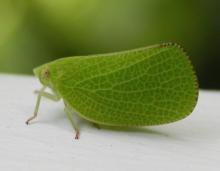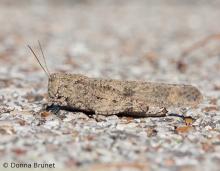Land Invertebrates
Media

Species Types
Scientific Name
More than 900 species in North America north of Mexico
Description
Planthoppers are a large and diverse group of small hopping bugs. They tend to be less abundant than other types of hoppers.
Media

Species Types
Scientific Name
More than 260 species in North America North of Mexico
Description
Treehoppers can resemble thorns, bark, weird plant bumps, or tiny leaves. If you can recognize one of these as an insect, you're doing well!
Media

Species Types
Scientific Name
Neoscona spp.
Description
Missouri's Neoscona spiders, called spotted orbweavers, can be hard to identify to species. Most have camouflage patterns, and they all make the characteristic, delicate, wheel-shaped webs to catch prey.
Media

Species Types
Scientific Name
Leucauge venusta
Description
The orchard orbweaver is a small, colorful, greenish, delicate spider that makes circular webs in low bushes and damp woodlands. It typically hangs in the middle of its web, its back to the ground.
Media

Species Types
Scientific Name
Dissosteira carolina
Description
The Carolina grasshopper is frequently seen in dusty, open habitats like dirt roads and vacant lots. Its yellow-bordered, black hindwings make it look like a mourning cloak butterfly.
Media

Species Types
Scientific Name
About 2,000 species in North America north of Mexico
Description
Plant bugs, or mirids, are a huge family of true bugs. They are often overlooked — except by gardeners and farmers. Most mirids eat plants, and some are agricultural pests. As a group, they’re an important food source for birds and other insectivores.
Media

Species Types
Scientific Name
About 1,300 species in North America north of Mexico
Description
The longlegged flies are a large, diverse fly family. They often have eye-catching metallic green, copper, bronze, or blue bodies and long legs. Their delicate wings are often clear and look iridescent in bright light, but many species have dark marks near the wing tips.
Media

Species Types
Scientific Name
About 1,700 species in North America north of Mexico
Description
The scarab beetle family is very large, with breathtaking variety — and often great beauty. Many scarabs are large and colorful.
See Also



Media

Species Types
Scientific Name
Cisseps fulvicollis
Description
The yellow-collared scape moth is more often “orange-collared.” And whether you think it looks more like a firefly or a wasp, it’s still a moth!
Media

Species Types
Scientific Name
Nearly 150 species in North America north of Mexico
Description
Slim, delicate plume moths are instantly recognizable by their T-shaped silhouette, long legs, and muted shades of tan and brown. It can be hard to separate the various species.
Media

Species Types
Scientific Name
Pyrrharctia isabella
Description
Not many people know the adult Isabella tiger moth when they see one, but we’re all acquainted with its caterpillar, the woolly worm, or woolly bear.
About Land Invertebrates in Missouri
Invertebrates are animals without backbones, including earthworms, slugs, snails, and arthropods. Arthropods—invertebrates with “jointed legs” — are a group of invertebrates that includes crayfish, shrimp, millipedes, centipedes, mites, spiders, and insects. There may be as many as 10 million species of insects alive on earth today, and they probably constitute more than 90 percent all animal species.





















